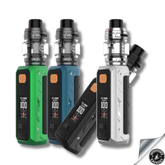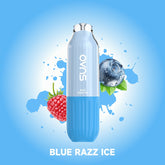Do E-Liquids Contain Antifreeze?
Introduction
There's a prevailing concern among many individuals that e-liquids, used in vaping devices, might contain antifreeze components, particularly alarming given the toxic nature of antifreeze. This blog aims to dispel such myths by providing a detailed, factual examination of e-liquid ingredients, with a focus on Propylene Glycol (PG), a compound often cited in this context. Our goal is to clarify misconceptions and ensure that readers are well-informed about the substances they are potentially inhaling.
Understanding E-Liquid Ingredients
E-liquids, the fluid used in vaping devices, primarily consist of a few key ingredients: Propylene Glycol (PG), Vegetable Glycerine (VG), flavourings, and often nicotine. Among these, PG plays a pivotal role due to its unique properties.
Propylene Glycol (PG) in E-Liquids
Propylene Glycol is a colourless, odourless liquid that is known for its ability to carry flavours and create a 'throat hit', which many vapers find essential to their experience. Its inclusion in e-liquids serves multiple purposes:
- Flavour Carrier: PG is excellent at dissolving flavouring agents, ensuring that the e-liquid imparts a consistent taste.
- Throat Hit: Similar to the sensation smokers get from traditional cigarettes, PG can create a satisfying throat hit, enhancing the overall vaping experience.
- Viscosity Control: While VG is thick and creates more vapour, PG is thinner and helps in reducing the viscosity of the e-liquid, making it easier to wick in various vaping devices.
Propylene Glycol and Its Uses
Propylene Glycol is a versatile substance used in various industries, highlighting its safety and effectiveness in different applications.
Broad Range of Applications
- Food Industry: PG is used as a food additive, helping to maintain moisture, dissolve flavours, and preserve substances. It's found in products like ice cream, liquid sweeteners, and commercial dressings.
- Pharmaceuticals: In medicine, PG serves as a solvent in oral, injectable, and topical formulations, proving its safety for human consumption and application.
- Cosmetics: It's utilised in cosmetics for its ability to retain moisture and enhance the texture of products.
Differentiation from Antifreeze Usage
While it's true that PG is an ingredient in certain antifreeze formulations, the context significantly differs:
- Antifreeze: In antifreeze, PG is used because of its low freezing point and non-toxic nature compared to ethylene glycol, a more hazardous antifreeze ingredient. The PG used in antifreeze is formulated for industrial use, not for consumption or inhalation.
- Concentration and Context: The concentration and purpose of PG in antifreeze are entirely different from its use in e-liquids. In vaping liquids, PG is diluted and combined with other safe ingredients, tailored for inhalation and human consumption, unlike its industrial antifreeze counterpart.
In the next sections, we'll delve deeper into the misconceptions surrounding PG and its safety profile, ensuring a comprehensive understanding of its role in e-liquids and broader applications.
The Antifreeze Confusion
Clarifying the Misconception
The connection between e-liquids and antifreeze primarily revolves around the presence of Propylene Glycol (PG). While it's true that PG is a component in antifreeze, this has led to a significant misunderstanding. The crucial distinction lies in the purpose and formulation of PG in different products.
PG in E-Liquids vs. Antifreeze Formulations
In antifreeze, PG serves to lower the freezing point of water, preventing the liquid from solidifying under cold temperatures, which is crucial for the protection of engines and heating systems. However, the PG used in e-liquids is pharmaceutical grade, designed for human inhalation and consumption, unlike the industrial-grade PG used in antifreeze. Moreover, the concentrations and additional ingredients in e-liquids are tailored for safety and efficacy in vaping, not for engine cooling.
FDA's Stance on Propylene Glycol
FDA's Recognition of PG Safety
The U.S. Food and Drug Administration (FDA) recognizes Propylene Glycol as "generally recognized as safe" (GRAS) for use in food and pharmaceutical products. This designation indicates that PG, when used as intended in regulated products, has been evaluated for safety and deemed acceptable for consumption or use in certain contexts.
Evaluating the Safety of PG
The FDA’s evaluation of PG includes reviewing scientific studies and data on its metabolism, toxicology, and interaction with the human body. The criteria for such evaluations are stringent, ensuring that substances like PG meet safety standards when consumed or inhaled in the context of food products or e-liquids. This endorsement underlines the significant difference between the consumption-grade PG found in e-liquids and the industrial-grade PG used in antifreeze, reinforcing the safety profile of PG in vaping products.
Propylene Glycol in Food Products
Propylene Glycol (PG) is a versatile substance not only prevalent in the e-liquid industry but also widely used in the food sector. Understanding its role in food can help demystify its presence in e-liquids and reassure about its safety.
PG in Everyday Food Items
PG is a common ingredient in numerous food products that we consume regularly. For instance, it serves as a food additive in ice cream, where it helps to maintain a creamy texture and prevent the formation of ice crystals. Similarly, in margarine, PG contributes to the consistency and shelf life of the product. These examples underscore PG's role in enhancing the quality and longevity of food items, demonstrating its benign nature when used in regulated amounts.
Safety and Regulatory Approvals
The widespread use of Propylene Glycol in the food industry is a testament to its safety when consumed in appropriate quantities. Regulatory bodies, such as the Food and Drug Administration (FDA), have evaluated PG and deemed it safe for human consumption. This endorsement underlines the fact that the presence of PG in food products, and by extension in e-liquids, is not a cause for health concerns but rather a reflection of its versatility and utility in various applications.
Conclusion
The inclusion of Propylene Glycol in e-liquids has stirred concerns due to its association with antifreeze; however, this connection is largely a misconception. PG is a compound recognised for its safety and is prevalent in many food products, from ice cream to margarine, highlighting its accepted use in consumption. E-liquids do not contain antifreeze but do utilise PG, a substance approved for human consumption and valued for its properties in both the food and vaping industries.
In navigating the world of e-liquids and their ingredients, it is vital for consumers to adopt informed perspectives, distinguishing between the industrial-grade PG used in antifreeze and the pharmaceutical-grade PG used in consumables. By understanding the context and safety standards surrounding PG, individuals can make more informed decisions about their vaping and dietary choices.






